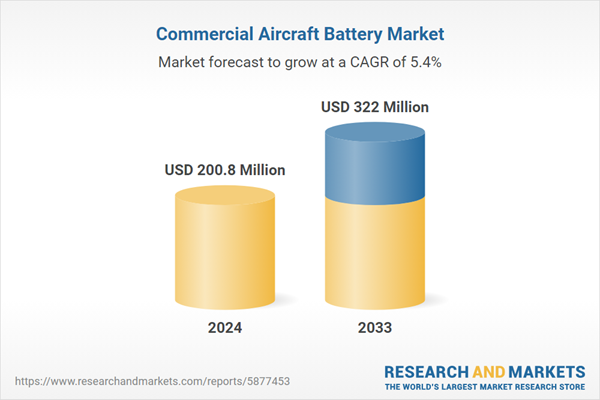Commercial aircraft batteries play a crucial role in modern aviation, providing power for essential systems and ensuring the safety and reliability of flights. They are specially designed to meet the stringent requirements of the aerospace industry. They are usually constructed using advanced technologies and high-quality materials to ensure optimal performance and longevity. The working principle of a commercial aircraft battery involves converting stored chemical energy into electrical energy, which is then used to power various aircraft systems. This energy conversion is achieved through a chemical reaction that occurs within the battery cells. Lead-acid, nickel-cadmium (NiCd), and lithium-ion (Li-ion) are some of the common types of batteries used in commercial aircrafts. These batteries offer enhanced safety by providing backup power in the event of an engine failure or electrical system malfunction. Moreover, they can also support auxiliary power during ground operations, reducing the need for external power sources and improving operational efficiency.
Commercial Aircraft Battery Market Trends:
The global commercial aircraft battery market is primarily driven by the increasing demand for more fuel-efficient and environmentally friendly aircraft and the growing emphasis on sustainable aviation. Moreover, the rising air passenger traffic and the subsequent expansion of the commercial airline fleet are boosting the market growth. This is further boosted by the growing trend of electric aircraft and hybrid-electric propulsion systems and rapid advancements in battery technologies, such as lithium-ion batteries with improved energy density and longer life cycles, are fueling market growth. Furthermore, the increasing focus on safety and the escalating need for reliable power sources in critical situations are accelerating the market growth. In line with this, the growing integration of advanced avionics systems, including electronic flight bags and in-flight entertainment systems, and the need for lightweight and compact batteries to optimize aircraft performance and reduce fuel consumption are contributing to the market growth. Other factors, including the implementation of various government initiatives to provide reliable backup power to critical systems, such as flight control, avionics, and emergency lighting, the growing need for reliable and efficient battery systems, and enhanced focus on research and development (R&D) activities, are presenting remunerative growth opportunities for the market.Key Market Segmentation:
The publisher provides an analysis of the key trends in each segment of the global commercial aircraft battery market, along with forecasts at the global, regional and country levels from 2025-2033. Our report has categorized the market based on type and application.Type Insights:
- Lithium-based Battery
- Nickel-based Battery
- Lead Acid Battery
Application Insights:
- Main Battery
- Auxiliary Power Unit (APU) Battery
Regional Insights:
- North America
- United States
- Canada
- Asia Pacific
- China
- Japan
- India
- South Korea
- Australia
- Indonesia
- Others
- Europe
- Germany
- France
- United Kingdom
- Italy
- Spain
- Russia
- Others
- Latin America
- Brazil
- Mexico
- Others
- Middle East and Africa
Competitive Landscape:
The report has also provided a comprehensive analysis of the competitive landscape in the global commercial aircraft battery market. Detailed profiles of all major companies have been provided. Some of the companies covered include Concorde Battery Corporation, EaglePicher Technologies, Enersys, HBL Power Systems Ltd., Saft (TotalEnergies), True Blue Power (Mid-Continent Instrument Co. Inc.), etc. Kindly note that this only represents a partial list of companies, and the complete list has been provided in the report.Key Questions Answered in This Report:
- How has the global commercial aircraft battery market performed so far, and how will it perform in the coming years ?
- What are the drivers, restraints, and opportunities in the global commercial aircraft battery market ?
- What is the impact of each driver, restraint, and opportunity on the global commercial aircraft battery market ?
- What are the key regional markets ?
- Which countries represent the most attractive commercial aircraft battery market ?
- What is the breakup of the market based on type ?
- Which is the most attractive type in the commercial aircraft battery market ?
- What is the breakup of the market based on the application ?
- Which is the most attractive application in the commercial aircraft battery market ?
- What is the competitive structure of the global commercial aircraft battery market ?
- Who are the key players/companies in the global commercial aircraft battery market ?
Table of Contents
Companies Mentioned
- Concorde Battery Corporation
- EaglePicher Technologies
- Enersys
- HBL Power Systems Ltd.
- Saft (TotalEnergies)
- True Blue Power (Mid-Continent Instrument Co. Inc.)
Table Information
| Report Attribute | Details |
|---|---|
| No. of Pages | 137 |
| Published | March 2025 |
| Forecast Period | 2024 - 2033 |
| Estimated Market Value ( USD | $ 200.8 Million |
| Forecasted Market Value ( USD | $ 322 Million |
| Compound Annual Growth Rate | 5.4% |
| Regions Covered | Global |
| No. of Companies Mentioned | 6 |









